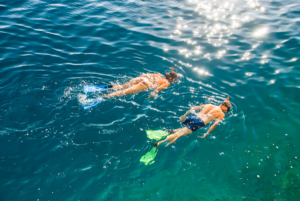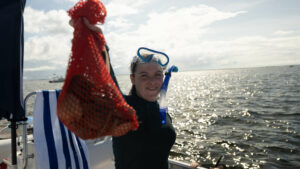Scalloping is an annual tradition for many Floridians and visitors that want to have a fun and relaxing summer day on the water on Florida’s Nature Coast. Practically anyone that can swim can be successful in collecting scallops, and those that have snorkeled before will feel right at home in the water.
Scallops migrate annually to the shallow coastal grass flats off the Crystal River coast. They are often found in less than 6 feet of water, where they can easily be captured by snorkelers exploring the flats. The muscle that closes the shell is a small delectable piece of meat. Since each boat can collect up to 10 gallons of whole scallops, a successful day can result in a bunch of scallop meat.
As a first-time scallop hunter, you can do a few things to increase your success.
First, get your snorkel gear on and explore around the boat to get comfortable in the water. Swimming in the flats is safe, however, some people feel anxious about being in the new environment. Before focusing on finding scallops, familiarize yourself with the snorkel gear by getting in the water and swimming around the area, practice keeping your head in the water and focusing on the bottom as you get used to breathing with a snorkel.
Practice diving and clearing your snorkel by forcefully exhaling when you surface. Spend time looking around the area to get used to the immersive experience, and look for fish and other marine life while you are exploring. Check the fit of your mask, you shouldn’t have any leaks. If your mask is fogging, ask for antifog from the captain or coat the inside of the mask with spit to decrease fogging. Make sure your fins are tight and not rubbing.
Now you are prepared to begin your search for the scallops that are laying amongst the grass. Your captain will show you what to look for…The shell pattern is easy for some people to pick out in the grass, others more easily see the row of blue eyes along the shell opening. Either way, jump in the water and begin slowly swimming at the surface and studying the bottom.
The scallops can be anywhere on the grass flat. It may be helpful to find gaps in the grass, such as sandy patches or areas of thinner grass. Study this area to find your first scallop. Once you find a scallop, search harder in that area, they are often grouped together. Put the scallops in your mesh bag and continue the hunt. You will find it easier to see scallops if you swim directly up current since you will be able to see into the grass more easily as it is leaned over towards you.
Pick a search pattern to ensure that you are covering as much ground as possible. When you find the tide direction, swim into the tide directly away from the boat for a couple of hundred feet, then move over 10 feet or so and head back towards the boat. There are certainly other strategies, but the key is to survey as much of the area as possible.
Captain Jason Dozier, with ScallopNFL, has years of experience helping clients have successful scallop trips. Contact him today to secure one of the limited scallop trips still available during this year’s season from July 1 through September 24.


